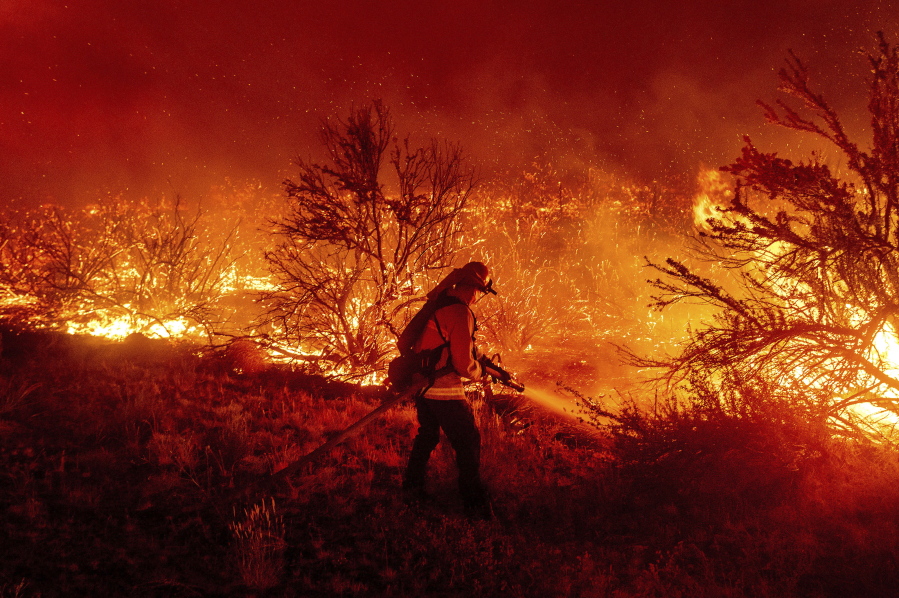BOISE, Idaho — At nearly every community meeting on firefighting efforts in the U.S. West, residents want to know why crews don’t simply put out the flames to save their homes and the valuable forests surrounding them.
It’s not that simple, wildfire managers say, and the reasons are many, some of them decades in the making and tied to climate change. The cumulative result has been an increase in gigantic wildfires with extreme and unpredictable behavior threatening communities that in some instances didn’t exist a few decades ago.
“How do we balance that risk to allow firefighters to be successful without transferring too much of that risk to the public?” said Evans Kuo, a “Type 1” incident commander assigned to the nation’s biggest and most dangerous wildfires. “I wish it wasn’t the case, but it’s a zero-sum game.”
More than 20,000 wildland firefighters are battling some 100 large wildfires in the U.S. West. Their goal is “containment,” meaning a fuel break has been built around the entire fire using natural barriers or manmade lines, often created with bulldozers or ground crews with hand tools.
Estimated containment dates for some wildfires now burning aren’t until October or November.
WHY SO LONG?
A big concern is safety. Kuo said residents sometimes plead with him to send firefighters into areas where he knows they could get killed.
“That’s a deal-breaker,” he said on a day off after 18 straight days of 5 a.m. to 10 p.m. shifts on a wildfire in Washington. “I’m not putting people at risk.”
Actually putting out these large fires, or labeling them “controlled,” will require cold weather combined with rain or snow, weeks away for many states.
HAVE WILDFIRES CHANGED?
Kuo has been fighting wildfires for 30 years with the U.S. Forest Service, spending the first part of his career as a frontline firefighter with groundcrews, the backbone of any effort to stop a wildfire. At the time, wildfires of 150 square miles were uncommon. Now blazes reach fives times that size and more, getting large enough to create their own weather.
“That’s kind of redefining what the new normal is,” Kuo said. “We get these megafires.”
IS WILDFIRE SUPPRESSION IN THE PAST PLAYING A ROLE NOW?
For much of the last century, firefighters had been mostly successful at suppressing wildfires in ecosystems that evolved to rely on wildfire. Early on, firefighters benefitted from forests that had already been periodically cleared of brush and debris by wildfires that could move through every couple decades. But with fire suppression, experts say, that brush and debris accumulated to where now, wildfires can ladder up into the branches and into the crowns of trees, creating the giant wildfires that kill entire swatches of a forest.
HOW HAS DROUGHT IMPACTED WILDFIRE SUPPRESSION?
On top of fire suppression have been several decades of drought that studies link to human-caused climate change. That’s exacerbated by this year’s hot and dry weather, leading to historically low moisture contents in forests that have become tinder-dry.
“Our protection districts are seeing far warmer and dryer than normal conditions creating historically dry fuels,” said Dustin Miller, director of the Idaho Department of Lands.
Those dry fuels allow wildfires to spread more quickly. On big fires, embers can shoot out to start spot fires on the other sides of natural barriers such as rivers. Sometimes spot fires can put firefighters at risk of being trapped by flames in front and behind them.
ARE THERE ENOUGH FIREFIGHTERS?
The nation has more than 20 Type 1 response teams to handle the nation’s biggest wildfires fires, and Kuo and his colleagues on those teams, like just about every other firefighting position this year, are in short supply.
He and his crew agreed to work longer than their 14-day shift on the Washington fire to make sure another crew would be available.
Another problem is lengthening wildfire seasons mean many seasonal firefighters leave for school well before wildfire season ends.



